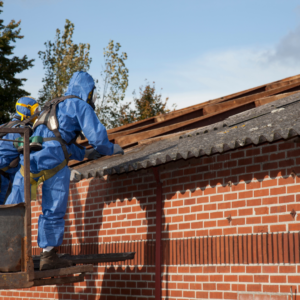Breathe Easier: Asbestos Safety Update
What is Asbestos
Asbestos is a naturally occurring fibrous silicate material known for its strength and resistance to heat, fire, chemicals, and wear. However, it’s also a carcinogen, and when disturbed, its tiny fibres can become airborne and pose serious health risks. All forms of asbestos can be harmful to humans.
Proper management of asbestos is essential to protect the health of your household or tenants. If asbestos removal is needed, it is strongly recommended that qualified professionals handle and dispose of it safely.
 Why asbestos is still a problem in New Zealand?
Why asbestos is still a problem in New Zealand?
Although asbestos is banned in Aotearoa, it continues to pose risks. Previously used in products like brake linings, filters, and fireproof textiles, asbestos was also a common material in buildings constructed before January 2000.
As these buildings age and require repairs, renovations, or demolition, the risk of disturbing asbestos increases. This can release harmful fibres into the air, posing significant health hazards to workers and those living or working nearby.
Learn more about where you might find asbestos in your building or workplace here.
New Guidelines
In October 2024, WorkSafe NZ updated its guidelines regarding asbestos. There is a dominant opinion that buildings constructed before 2000 are likely to be at a higher risk of containing this hazardous material. While buildings built after 2000 may still have asbestos, the risk is considered to be significantly lower.
If your building is considered likely to have asbestos the guidelines direct that actions be taken to assess the issue and that appropriate steps be taken in response to the findings of the assessment.
“Unidentified or damaged asbestos material can create a health risk for workers and other people in the workplace” – WorkSafe New Zealand.
If your building was constructed before 2000, it’s recommended to hire a qualified asbestos contractor to identify any asbestos present and manage its removal if necessary.
- Asbestos surveyors are trained professionals who assess buildings for asbestos. They collect information, conduct visual inspections, take samples of suspected materials, and provide comprehensive reports on their findings.
- Asbestos removalists are specialists trained to safely remove and dispose of asbestos.
- Asbestos assessors ensure that the removal work meets the required standards by conducting quality checks.
If your building was constructed after January 2000, while an inspection is not mandatory, it is still advisable to conduct an asbestos check as a precaution.
Next Steps
- Assessment: Your Strata manager will have been in touch with your Owners’ Committee to discuss engaging a suitable professional to conduct an assessment of your building.
- Findings: If asbestos is found you may then decide to move forward by hiring a licensed asbestos removalist to ensure safe removal and disposal.
- Develop an Asbestos Management Plan: You may also wish to create an asbestos identification and management plan to outline procedures for handling any identified asbestos in the future.
Learn more about Asbestos Guidelines here:
- Worksafe: Managing asbestos in your building or workplace – for PCBUs
- Tenancy Services: Landlords managing asbestos at the property
- Health & Safety at Work (Asbestos) Regulations 2016
If you have any questions or want to reach out to one of our body corporate experts email us at bc@stratatitle.co.nz or call us on 09 307 3721.




